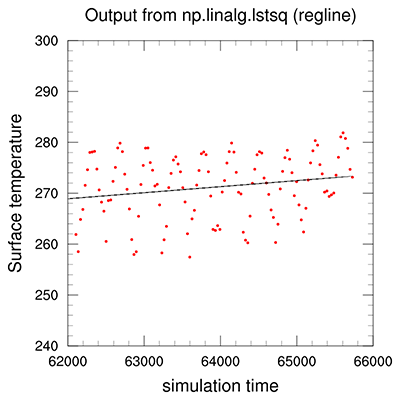DKRZ PyNGL example scatter plot with regression line#
Example:
import numpy as np
import Ngl
#---------------------------------------------------------------
# Function runave(data, xrange): compute the running mean
#
# Input: data data array
# xrange time range
#
# Return: running mean values
#---------------------------------------------------------------
def runave(data, xrange):
return np.convolve(data, np.ones((xrange,))/xrange, mode='valid')
#---------------------------------------------------------------
# Function regline(xin,yin): compute the regression line
#
# Input: xin x array
# yin data array
#
# Return: x,y x- and y-values of regression line
#---------------------------------------------------------------
def regline(xin,yin):
x = np.vstack([xin, np.ones(len(xin))]).T
m, t = np.linalg.lstsq(x, yin, rcond=None)[0] #-- returns gradient and y-intersection
y = (m*x)+t #-- regression line equation
return x, y
#-----------------------------------------------------------------------
#-- Function: main
#-----------------------------------------------------------------------
def main():
#-- file name
fname = 'tas_monmean_MPI-ESM-LR_rcp45_r1i1p1_20200101-20291231.nc'
#-- open file and read variables
a = Nio.open_file(fname,"r") #-- open data file
tas = a.variables["tas"][:,:,:] #-- read variable tas
lat = a.variables["lat"][:] #-- get whole "lat" variable
lon = a.variables["lon"][:] #-- get whole "lon" variable
time = a.variables["time"][:] #-- number of timesteps
ntime = time.size
#-- set lat/lon point
latval = 60 #-- extract lat 60N
lonval = 180 #-- extract lon 180W
#-- retrieve the indices of lat/lon point
indlat = min(range(len(lat)), key=lambda i: abs(lat[i]-latval))
indlon = min(range(len(lon)), key=lambda i: abs(lon[i]-lonval))
#-- select the data of lat/lon point for all timesteps
ts = tas[:,indlat,indlon]
#-----------------------------------------------------------
# Smooth data so that seasonal cycle is less prominent. This
# is for demo purposes only so that the regression line is
# more sloped.
#-----------------------------------------------------------
rmean = runave(ts,40)
#-----------------------------------------------------------
# Create x and calculate the regression coefficient.
#-----------------------------------------------------------
x, y = regline(time,ts)
#-----------------------------------------------------------
# Graphics
#-----------------------------------------------------------
wks = Ngl.open_wks("png","plot_scatter_regline")
#-- plot resources
res = Ngl.Resources()
res.nglDraw = False #-- don't draw plot
res.nglFrame = False #-- don't advance the frame
res.nglMaximize = True #-- maximize plot
res.tiMainString = "Output from np.linalg.lstsq (regline)" #-- add title
res.tiXAxisString = "simulation time"
res.tiYAxisString = "Surface temperature"
res.xyMarkLineModes = "Markers" #-- use markers
res.xyMarker = 16 #-- filled circle
res.xyMarkerSizeF = 0.005 #-- default: 0.01
res.xyMarkerColor = "red" #-- marker color
res.trYMinF = 240
res.trYMaxF = 300
#-- create xy-plot of ts
plot0 = Ngl.xy(wks,time,ts,res) #-- create the xy plot
#-- change resource settings for regression line
res.xyMarkLineModes = "Lines" #-- use lines
res.xyMarker = 1 #-- solid line
res.xyMarkerColor = "black" #-- marker color
#-- create plot of regression line
plot1 = Ngl.xy(wks,x,y,res)
#-- overlay regression line plot on xy plot
Ngl.overlay(plot0,plot1)
#-- draw plot and advance the frame
Ngl.draw(plot0)
Ngl.frame(wks)
Ngl.end()
if __name__ == '__main__':
main()
Result:
